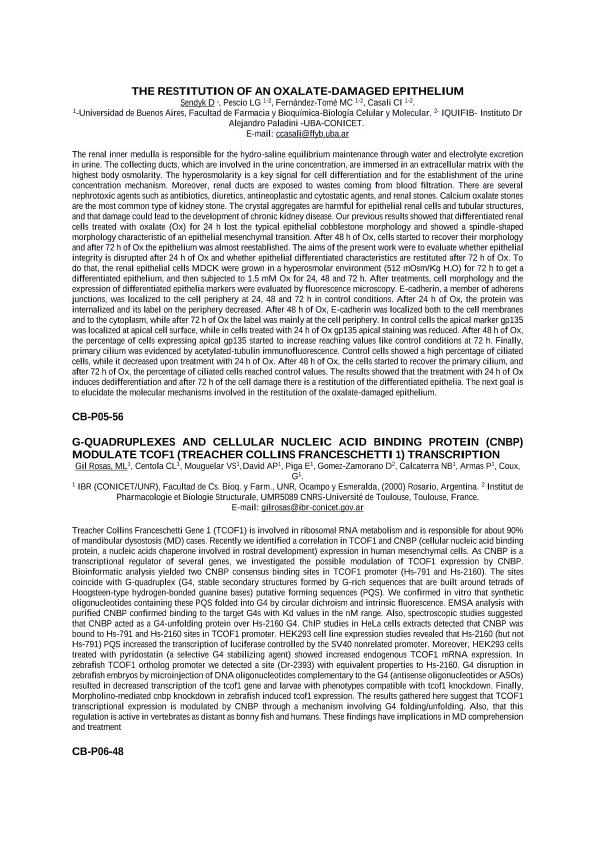Evento
The restitution of an oxalate-damaged epithelium
Tipo del evento:
Reunión
Nombre del evento:
LVII Annual Meeting of the Argentine Society for Biochemistry and Molecular Biology Research and XVI Annual Meeting of the Argentinean Society for General Microbiology
Fecha del evento:
11/2021
Institución Organizadora:
Sociedad Argentina de Investigación Bioquímica y Biología Molecular;
Asociación Civil de Microbiología General;
Título de la revista:
Biocell
Editorial:
Tech Science Press
ISSN:
1667-5746
Idioma:
Inglés
Clasificación temática:
Resumen
The renal inner medulla is responsible for the hydro-saline equilibrium maintenance through water and electrolyte excretionin urine. The collecting ducts, which are involved in the urine concentration, are immersed in an extracellular matrix with thehighest body osmolarity. The hyperosmolarity is a key signal for cell differentiation and for the establishment of the urineconcentration mechanism. Moreover, renal ducts are exposed to wastes coming from blood filtration. There are severalnephrotoxic agents such as antibiotics, diuretics, antineoplastic and cytostatic agents, and renal stones. Calcium oxalate stonesare the most common type of kidney stone. The crystal aggregates are harmful for epithelial renal cells and tubular structures,and that damage could lead to the development of chronic kidney disease. Our previous results showed that differentiated renalcells treated with oxalate (Ox) for 24 h lost the typical epithelial cobblestone morphology and showed a spindle-shapedmorphology characteristic of an epithelial mesenchymal transition. After 48 h of Ox, cells started to recover their morphologyand after 72 h of Ox the epithelium was almost reestablished. The aims of the present work were to evaluate whether epithelialintegrity is disrupted after 24 h of Ox and whether epithelial differentiated characteristics are restituted after 72 h of Ox. Todo that, the renal epithelial cells MDCK were grown in a hyperosmolar environment (512 mOsm/Kg H2O) for 72 h to get adifferentiated epithelium, and then subjected to 1.5 mM Ox for 24, 48 and 72 h. After treatments, cell morphology and theexpression of differentiated epithelia markers were evaluated by fluorescence microscopy. E-cadherin, a member of adherensjunctions, was localized to the cell periphery at 24, 48 and 72 h in control conditions. After 24 h of Ox, the protein wasinternalized and its label on the periphery decreased. After 48 h of Ox, E-cadherin was localized both to the cell membranesand to the cytoplasm, while after 72 h of Ox the label was mainly at the cell periphery. In control cells the apical marker gp135was localized at apical cell surface, while in cells treated with 24 h of Ox gp135 apical staining was reduced. After 48 h of Ox,the percentage of cells expressing apical gp135 started to increase reaching values like control conditions at 72 h. Finally,primary cilium was evidenced by acetylated-tubulin immunofluorescence. Control cells showed a high percentage of ciliatedcells, while it decreased upon treatment with 24 h of Ox. After 48 h of Ox, the cells started to recover the primary cilium, andafter 72 h of Ox, the percentage of ciliated cells reached control values. The results showed that the treatment with 24 h of Oxinduces dedifferentiation and after 72 h of the cell damage there is a restitution of the differentiated epithelia. The next goal isto elucidate the molecular mechanisms involved in the restitution of the oxalate-damaged epithelium.
Palabras clave:
EPITHELIAL RESTITUTION
,
OXALATE
Archivos asociados
Licencia
Identificadores
Colecciones
Eventos(IQUIFIB)
Eventos de INST.DE QUIMICA Y FISICO-QUIMICA BIOLOGICAS "PROF. ALEJANDRO C. PALADINI"
Eventos de INST.DE QUIMICA Y FISICO-QUIMICA BIOLOGICAS "PROF. ALEJANDRO C. PALADINI"
Citación
The restitution of an oxalate-damaged epithelium; LVII Annual Meeting of the Argentine Society for Biochemistry and Molecular Biology Research and XVI Annual Meeting of the Argentinean Society for General Microbiology; Virtual; Argentina; 2021; 71-71
Compartir




